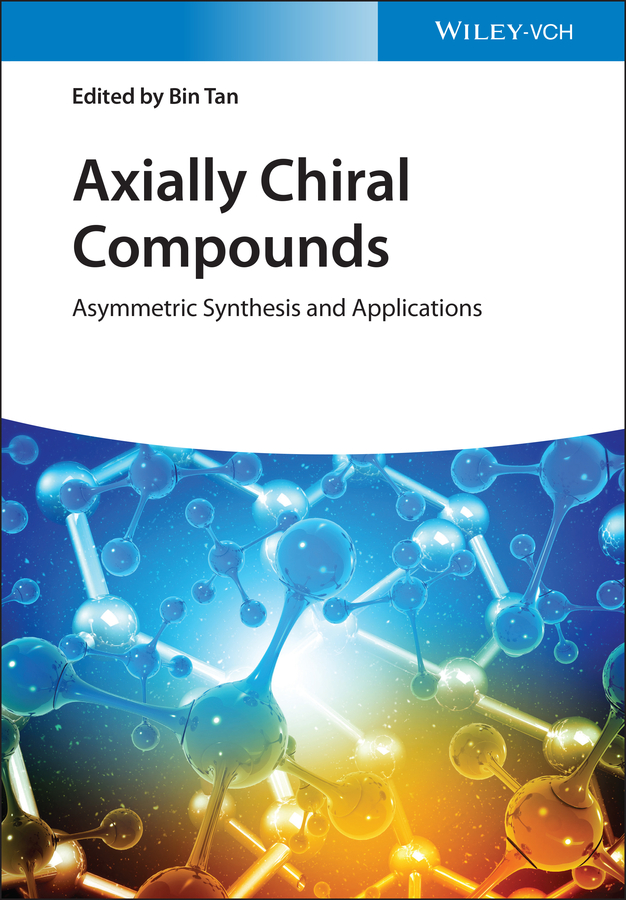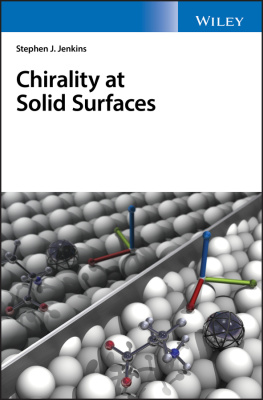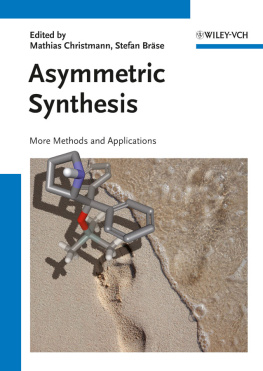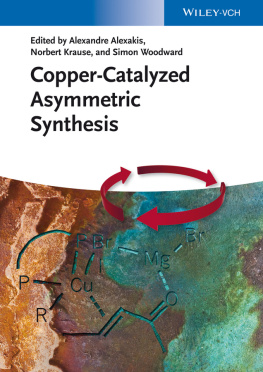
Table of Contents
List of Tables
- Chapter 9
List of Illustrations
- Chapter 1
- Chapter 2
- Chapter 3
- Chapter 4
- Chapter 5
- Chapter 6
- Chapter 7
- Chapter 8
- Chapter 9
- Chapter 10
- Chapter 11
Guide
Pages
Axially Chiral Compounds
Asymmetric Synthesis and Applications
Edited by
Bin Tan

Editor
Prof. Bin Tan
Southern University of Science and Technology
Chemistry Department
NO. 1088, Xueyuan Road
Nanshan District
518055 Shenzhen
China
Cover
Cover Design: Wiley
Cover Image: Rasi Bhadramani/Getty Images
All books published by WILEY-VCH are carefully produced. Nevertheless, authors, editors, and publisher do not warrant the information contained in these books, including this book, to be free of errors. Readers are advised to keep in mind that statements, data, illustrations, procedural details or other items may inadvertently be inaccurate.
Library of Congress Card No.:
applied for
British Library Cataloguing-in-Publication Data
A catalogue record for this book is available from the British Library.
Bibliographic information published by the Deutsche Nationalbibliothek
The Deutsche Nationalbibliothek lists this publication in the Deutsche Nationalbibliografie; detailed bibliographic data are available on the Internet at .
2021 WILEY-VCH GmbH, Boschstr. 12, 69469 Weinheim, Germany
All rights reserved (including those of translation into other languages). No part of this book may be reproduced in any form by photoprinting, microfilm, or any other means nor transmitted or translated into a machine language without written permission from the publishers. Registered names, trademarks, etc. used in this book, even when not specifically marked as such, are not to be considered unprotected by law.
Print ISBN: 978-3-527-34712-4
ePDF ISBN: 978-3-527-82516-5
ePub ISBN: 978-3-527-82518-9
oBook ISBN: 978-3-527-82517-2
Preface
Axial chirality refers to stereoisomerism that is derived from the nonplanar arrangement of four substituents in pairs about a stereogenic axis. Compared to the immense research efforts dedicated to central chirality at the outset of the study of molecular chirality, the popularization of axial chirality has undergone a slower start. For instance, atropisomerism, as the most representative subclass of axial chirality, was not discovered until 1922 by Christie and Kenner. This form of molecular asymmetry then went largely unnoticed for the following half-century probably because of the unveiled application potential as well as complications to deal with the dynamic nature of this stereoisomerism. In 1980s, the huge success of optically active 2,2-bis(diphenylphosphino)-1,1-binaphthyl ( BINAP ) ligand (creatively developed by professor Ryoji Noyori) in transition metal-catalyzed asymmetric transformations ignited the research passion about axial chirality. Over the next several decades, axial chirality holds increasing attention and has since constituted an important arena for novel discoveries that impact diverse domains of chemical science. Today, axially chiral motifs are common in functional compounds in which well-defined three-dimensional scaffolds are valuable, such as those pursued in asymmetric synthesis, medicinal, and materials science. In conjunction with these demands, an exploding list of prominent strategies has been ingeniously devised to access the privileged axially chiral scaffolds, which have substantially benefited from the continuous evolution of asymmetric catalysis.
Among the divergent research domains concerning axial chirality, the exploitation of novel molecular frameworks, the development of stereoselective and efficient synthetic approaches (particularly in a catalytic fashion), as well as the extension of the application range are the central themes. Meanwhile, comprehensive and instructive handbook that could enable fellow students and researchers to glean insights into this field concisely has remained scarce.
Cognizant of this gap, we write this book focusing on the asymmetric synthesis and applications of axially chiral compounds with a view to inform readers about the development history, research status, and applications of axial chirality. This monograph is developed to cover two main themes that are categorized into 11 chapters. It commences with an in-depth introduction of axial chirality, which sets the backdrop for subsequent discussions. This encompasses the tactic to assign stereochemistry for different subclasses of axially chiral molecules in accordance with CahnIngoldPrelog priority rules, coupled with descriptions on their defining structural features. The focus is then shifted to introduce various asymmetric approaches to synthesize enantioenriched axially chiral molecules, comprising atropisomerically enriched biaryls, heterobiaryls, non-biaryls, allenes, as well as natural products bearing axially chiral elements in a collective manner. In the second part, the importance of axially chiral molecules is detailed by showcasing the versatile transformations that are demonstrated on these scaffolds, followed by their applications in asymmetric catalysis as chiral ligands or organocatalysts. Beyond chemical synthesis, the important roles of axial chirality elements in recognition and interaction events in biochemistry and materials science are described. The two main themes compose the content of this book, through which the high relevance of axial chirality to different chemistry disciplines and their interrelation are highlighted. It is projected to serve as guidance to chemists in the field and to inspire incursions into unexplored areas of axial chirality in both academic and industrial settings.
I would like to take this opportunity to thank the WileyVCH editorial staffs for their proposal and guidance to complete this monograph. It has been my honor to collaborate with Prof. Bing-Feng Shi and colleague (Dr Tao Zhou), Prof. Jean Rodriguez, Prof. Damien Bonne, Prof. Jeffrey L. Gustafson and his team (Dr Mirza A. Saputra, Mariel Cardenas), Prof. Yun-He Xu, Prof. Jinbo Zhao, Prof. Wen-Jun Tang and his colleague (He Yang), Prof. Mukund P. Sibi and his coworker (Dr Gaoyuan Ma), as well as Prof. Takahiko Akiyama who generously devoted their precious time and shared their expertise in accomplishing this book. I would also like to acknowledge the contributions of my colleagues and students, Yong-Bin Wang, Bin-Chao Da, Shaoyu Li, Shao-Hua Xiang, and Jun-Kee Cheng in composition and revision of this book.
Part I
Asymmetric Synthesis
Introduction and Characteristics
Yong-Bin Wang, Shao-Hua Xiang, and Bin Tan
Department of Chemistry, Southern University of Science and Technology, No. 1088, Xueyuan Rd., Nanshan District, Shenzhen, 518055, China
1.1 Introduction and Classification
If a rigid object or the spatial arrangement of points including atoms is nonsuperposable on its mirror image, such an object possesses no symmetry elements of the second kind and the geometric property displayed is denoted as chirality (IUPAC). Chirality is widely represented in nature and plays crucial roles in life-sustaining processes. In living systems, chiral homogeneity of monomer units (such as -amino acid and nucleoside) is found to induce more rapid polymerization and longer chain length of biopolymers (proteins, DNA, or RNA). Thus, the biomacromolecules assembled from the homochiral monomeric building blocks exhibit homochirality, which is considered the sine qua non for molecule-based life. As such, virtually all chiral biomolecules including small monomers and biopolymers in living organisms are enantiomerically pure to engender biological homochirality. This affects the differential interactions between biomacromolecules with a pair of enantiomers ]. Taken together, asymmetric synthesis toward molecular targets with high stereochemical purities has been a central research theme in many organic chemistry-oriented research laboratories.
Next page





